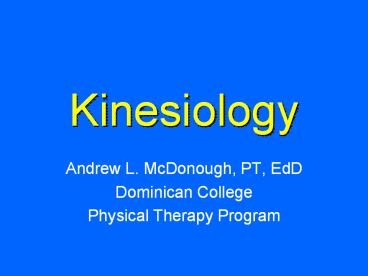Kinesiology - PowerPoint PPT Presentation
Title:
Kinesiology
Description:
Tension realized is the sum-total of contractile & non-contractile elements ... Tension production will soon become linear and muscle fiber will react elastically ... – PowerPoint PPT presentation
Number of Views:429
Avg rating:3.0/5.0
Title: Kinesiology
1
Kinesiology
- Andrew L. McDonough, PT, EdD
- Dominican College
- Physical Therapy Program
2
Kinesiology
- Functional anatomy (traditional)
- Biomechanics
- Statics
- Dynamics
- Kinematics (geometry of motion)
- Kinetics (forces that account for motion)
3
Voluntary Movement Factors Levels of Analysis
- (Macro)physiologic
- Biomechanics
- Motor control
- Motor learning
4
Types of Motion
- Translatory
- A
B - Rotary constant radius
- Curvilinear radius varies
5
Basic Components of aJoint System
- Muscle attachments (proximal distal)
- Axis of rotation
- Fixed center
- Instant center
- Innervation
6
Terms
- Agonist Antagonist (context-dependent)
- Synergist (3 definitions)
- Primary vs. Secondary (Tertiary) movers
- Fixators/stabilizers Immobilizers
7
Muscle Factors
- Physiological cross-section
- Geometry of muscle/tendon
8
Physiological Cross-Section
Less force
More force
9
Geometry
- Type types
- Fusiform (cigar-shaped)
- Penniform (feather-shaped)
- Bi-pennate
- Uni-pennate
- Multi-pennate
Bi-
Uni-
Multi-
10
Significance of Geometry
- Fusiform
- Parallel arrangement of fibers (all have same
proximal and distal attachments) - Virtually ALL (less 10) of force delivered to
attachments - Have large force (torque) generating potential
- Muscles/fibers to be impulsive but not endurant
11
Significance of Geometry
- Penniform
- Implies an angle-of-insertion
- Gross muscle level
- Muscle fiber level
.
angle-of-insertion
12
Angle-of-insertion
resultant force
X
.
angle-of-insertion
axis
rotary component (Y) force
.
900
(joint) compressive component (X)
T f x d
13
Muscle Contraction Types
- Isometric
- Isotonic
- Concentric (shortening contraction)
- Eccentric (lengthening contraction)
- Isokinetic (?)
14
Muscle ContractionLevels of Analysis
- Sarcomere (microanatomical)
- Gross muscle
15
Isometric Contraction
- Sarcomere shortens delivering force to tendon
- Gross length remains constant
Demo
16
Concentric Contraction
- Sarcomere shortens
- Gross muscle shortens pulling on bony attachments
- If the muscle crosses a joint the joints moves
through a ROM via torque created
Demo
17
Eccentric Contraction
- A lengthening reaction
- Occurs in a muscle that has already undergone a
concentric contraction - External force applied exceeds internal muscular
force being generated - Muscle lengthens under neuro-motor control
18
Sources of Tension
- Muscle (contractile element)
- Tendon (non-contractile element CT)
19
Premise Concentric vs. Eccentric Contractions
- Per comparable volumes of muscle tissue, more
tension will always be realized during eccentric
contractions.
20
Analysis
- Concentric contraction
- Source of tension
- Contractile elements (muscle)
- Eccentric contraction
- Source of tension
- Contractile elements (muscle)
- Non-contractile elements (CT tendon)
- The tendon is in a pre-loaded condition due to
previous concentric contraction
21
EMG Activity
- Ratio 0.5 1.0 (eccentric concentric)
- Tension realized is the sum-total of contractile
non-contractile elements - Muscle working eccentrically will not have to
work as hard since some the total tension is
provided by the pre-loaded tendon
22
Metabolic Activity
- Consequently if the muscle is not working as hard
under eccentric control less energy is required
to sustain a contraction by a factor of 10 30 - Less lactic acid is produced eccentrically
23
Muscle Contraction Fiber Types
- Concentric Type I and IIa motor units most
active - Eccentric Type IIb motor units most active
24
Relationship Between a Muscle (or Muscle Fiber)
Tension Production
- Blix experiments
probe
dynamometer
frog soleus muscle fiber
25
Muscle Lengthened Passively
- Tension production will soon become linear and
muscle fiber will react elastically
Passive Tension Curve
Tension
Length
26
Muscle Stimulated at VariousPre-set Lengths
Shortening Lengthening
60
Blix Curve or Length-tension
Curve
Tension
0
100
Rest length
Length
27
Length-Tension Relationship
- During active contraction a muscle (or muscle
fiber) will generate maximal tension at or
slightly greater than rest length. - Levels of analysis
- Gross muscle
- Muscle fiber/sarcomere
Demo
28
Motor Control System
- Constantly evaluates tension via length
assessment (GTOs spindles) - Often optimizes tension via maintaining muscle
length - Usually goes out of its way to maintain length
29
Question
- What happens when a muscle is called upon to do
the job it is intended to do (i.e., shorten)?
30
Muscle Types
- One-joint
- Two (two-or-more)-joint
31
Active Insufficiency
- Two-joint muscle shortens simultaneously over
both joints - Rapidly loses length (shifts left on the
length-tension curve) - Force and torque production decrease quickly
32
Two-Joint MusclesGeneral Rule
- In a motor control context, two-muscles rarely
contract over both (all) joints simultaneously - While one end of the muscle is shortening over
its associated joint - The other end is being lengthened over its
associated joint - The net effect preserve length and therefore
force and torque - Motor control system avoids active insufficiency
in most cases
33
Passive Insufficiency
- Muscle passively elongated over both (all) joint
simultaneously - At some point the muscle reaches its elastic
limit - ROM will be limited across both joints
34
Velocity Tension Relationship
Concentric
Eccentric
Inverse Relationship
Tension
-
0
100
Demo
Velocity
35
Other Terms
- Strength ability to generate tension
- Power rate of doing work (Tf x d)
- Low power
- High power
- Endurance ability to sustain the work being
preformed
36
Other Terms
- Arthrokinematics study of the relationship
between (among) articulating bony surfaces - Joint play
- Congruency
- Component motion
- Overall motion
37
(No Transcript)































